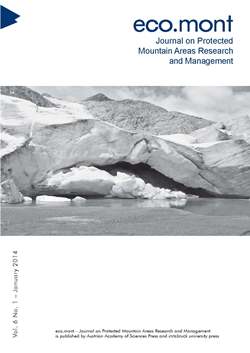 |
 |
Axel Borsdorf - Günter Köck (Eds.)
eco.mont
Journal on Protected Mountain Areas Research and Management
Beat Oertli,
Christiane Ilg,
Sandrine Angélibert,
Janine Bolliger,
Julien Crovadore,
Eliane Demierre,
Claire Julliand,
Andréa Finger-Stich,
Christel Forré,
Pierre-André Frossard,
François Lefort,
Mathieu Mayencourt,
Umberto Piantini,
Sergio Schmid
S. 23 - 34 doi: 10.1553/ecomont-6-1s23
Verlag der Österreichischen Akademie der Wissenschaften doi: 10.1553/ecomont-6-1s23
Abstract:
Freshwater biodiversity has shown to be highly vulnerable to climate warming. Boreo-alpine species are especially at risk in the Alps because they have to migrate to higher elevations to avoid local extinction. Effects of climate warming could be partly counteracted by creating new freshwater habitats: this would boost the population sizes of the endangered species and would increase the connectivity between Alpine waterbodies to facilitate the species’ upward dispersal and colonization of new habitats. Nevertheless, the localization of new habitats has to be carefully chosen, as successful restoration (or habitat creation) depends on many abiotic and ecological variables (e. g. habitats density and quality, connection between bodies of water, presence of targeted species, resistance of landscape to species movements). Furthermore, various socioeconomic drivers and actors determine the land and water uses in the Alps. Therefore we developed an innovative method for prioritization of areas for creation (or restoration) of small bodies of water, taking into account both ecological parameters (from species to landscape) and social ones. The method was developed in a test area (130 km2, in Canton Valais, Switzerland) representative of the Swiss Alpine landscapes and their associated socioeconomic activities. The proposed methodological framework consists of four steps which allow refining the geographical area to propose two or three small areas (some hectares) suitable for the creation of small water bodies. The first step investigates the regional scale, often several thousand km2, with a focus on environmental considerations: presence of historical or contemporary wetlands and waterbodies, presence of cold stenotherm species, and favourable landscape (in terms of land use) and socioeconomic context. The second step identifies areas of biological connectivity between source ponds and future host ponds for cold stenotherm species, taking into account the distance between source and host ponds and landscape resistance to the movements of propagules, finally highlighting the migration corridors. The third step checks the preselected areas with the aim of discarding catchments impaired by selective or diffuse pollutions. The fourth and final step is intended to enhance the probability of the project’s social acceptance: qualitative interviews and field observations are conducted on a local scale (often one km2) and options are evaluated with local stakeholders. Conducting the four successive and complementary steps ensures that the selected areas have a high potential for hosting the alpine biodiversity, and furthermore provide a favourable social framework for success in the short as well as the long term. Such a tool should promote and facilitate actions for conserving freshwater biodiversity in the Alps.
2014/01/28 08:24:26 Object Identifier:
0xc1aa5576 0x002f9162
Rights:https://creativecommons.org/licenses/by-nc-nd/4.0/
The journal “eco.mont” – Journal of protected mountain areas research and management – was published for the first time in June 2009.
The journal was founded as a joint initiative of the Alpine Network of Protected Areas (ALPARC), the International Scientific Committee on Research in the Alps (ISCAR), the Austrian Academy of Sciences (ÖAW) and the University of Innsbruck.
The journal aims to highlight research on and management issues in protected areas in the Alps without excluding other protected mountain areas in Europe or overseas. Its target audiences are scientists from all related disciplines, managers of protected areas and interested individuals including practitioners, visitors, teachers, etc.
The journal presents peer-reviewed articles in English by authors who research protected mountain areas and management issues within these areas. It's published twice a year as a collaboration of the Austrian Academy of Sciences Press – responsible for the e-version – and Innsbruck University Press – responsible for the print version.
Die Zeitschrift „eco.mont“ – Zeitschrift zur Forschung in Gebirgsschutzgebieten – erschien im Juni 2009 zum ersten Mal. Die Zeitschrift wurde auf Initiative des Netzwerks Alpiner Schutzgebiete (ALPARC), der Schweizer Akademie der Naturwissenschaften (ISCAR), der Österreichischen Akademie der Wissenschaften (ÖAW) und der Universität Innsbruck gegründet. Sie hat das Ziel, Themen zu behandeln, die gleichzeitig Forschung und Verwaltung in und über die Schutzgebiete der Alpen betreffen, ohne dabei andere Gebirgsschutzgebiete Europas oder anderswo auszuschließen. Diese neue Zeitschrift richtet sich an ein Publikum von Wissenschaftlern der verschiedensten Fachbereiche, an die Verwalter von Schutzgebieten und an alle sonstigen Interessierten, Praktiker, Besucher, Lehrpersonal etc. einbegriffen. Die Zeitschrift veröffentlicht begutachtete Beiträge auf Englisch von Autoren, die Fragen der Gebirgsschutzgebiete und deren Verwaltung betreffen. Sie erscheint zweimal pro Jahr, auf der Basis der gemeinsamen Anstrengungen des Verlags der Österreichischen Akademie der Wissenschaften, der für die digitale Fassung verantwortlich ist, und der Presse der Universität Innsbruck, verantwortlich für die gedruckte Fassung.
|



 Home
Home Print
Print
 References
References
 Share
Share

